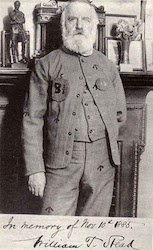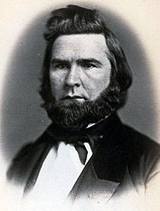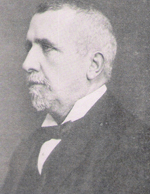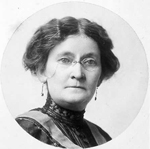|
|
|
 |
Automatic Writing Explained
Posted on 23 March 2015, 17:08
The so-called skeptics assume that the automatic writing form of mediumship is just so much bunk, baloney, and bosh, nothing more than the imagination playing tricks on the person. Some parapsychologists believe it is all coming from the individual’s subconscious and unrelated to spirits. But so much of what has come through automatic writing has been beyond the individual’s knowledge and experience that spirits are a much more reasonable explanation.
“Automatic writing, I may explain for those unfamiliar with the term, is writing that is written by the hand of a person which is not under control of his conscious mind,” William T. Stead, (below) a British journalist who went down with the Titanic, explained. “The hand apparently writes of itself, the person to whom the hand belongs having no knowledge of what it is about to write. It is a very familiar and simple form of mediumship.”

Considering the subconscious theory, Stead, an accomplished automatist, wrote that he could not believe that any part of his unconscious self would deliberately practice a hoax upon his conscious self about the most serious of all subjects, and keep it up year after year with the most sincerity and consistency. “The simple explanation that my friend who has passed over can use my hand as her own seems much more natural and probable.”
William Stainton Moses, an Anglican priest, was also an automatic writing medium. “During the whole time this communication was written, my spirit was separated from the body,” he explained. “I could see, from a short distance, the hand as it wrote. In my own room I felt an impression to write, such as I have not felt for nearly two months. I sat at my desk, and the first part was written. I presume I then passed into a state of unconscious trance. The next thing I remember was standing in spirit near to my body, which was seated holding the pen before the table on which this book was placed. I looked at it and the arrangements of the room with great interest. I saw that my body was there, and that I was joined to it by a thin line of light. Everything material in the room looked shadowy, and everything spiritual seemed solid and real.”
Moses added that the communicating spirit stood behind his body with his own hand over his, and he saw other spirits in the room at the same time. “Through the ceiling streamed down a mild, pleasing light, and now and again rays of bluish light were shot down on my body. When this was done, I saw the body jerk and quiver. It was being charged, as I may say. I noticed, moreover, that the daylight had faded; and the window seemed dark, and the light by which I saw was spirit-light. I could hear perfectly well the voices of the spirits who spoke to me. They sounded very much as human voices do, but were more delicately modulated, and sounded as though from a distance.”
It was explained to him that he was seeing an actual scene, which was intended to show him how the spirits operated. His hand was writing, but it was explained to him that it was not so much that the spirit was using his hand as it was the spirit was impressing his mind. “[It] was done by directing on to the pen a ray which looked like blue light. The force so directed caused the pen to move in obedience to the will of the directing spirit. In order to show me that the hand was a mere instrument, not essential to the experiment the pen was removed from the hand, and kept in position by the ray of light which was directed upon it. To my great surprise, it moved over the paper, and wrote as before…I do not remember the return to my body. I am perfectly certain as to what occurred, and report it simply and without exaggeration.”
Sidney Dean, (below) a member of Congress representing Connecticut from 1855 to 1859 and later a journalist and author, wrote to Professor William James of Harvard describing the strange writing that seemed to be coming from his hand but not from his brain. “Some of it is in hieroglyph, or strange compounded arbitrary characters, each series possessing a seeming unity in general design or character, followed by what purports to be a translation or rendering into mother English,” he explained to James. “I never attempted the seemingly impossible feat of copying the characters. They were cut with the precision of a graver’s tool, and generally with a single rapid stroke of the pencil. Many languages, some obsolete and passed from history, are professedly given. To see them would satisfy you that no one could copy them except by tracing.”

But this was a very small part of the phenomenon. “The ‘automatic’ has given place to the impressional, and when the work is in progress I am in the normal condition, and seemingly two minds, intelligences, persons, are practically engaged,” he continued. “The writing is in my own hand but the dictation not of my own mind and will, but that of another, upon subjects which I can have no knowledge and hardly a theory; and I, myself, consciously criticize the thought, fact, mode of expressing it, etc., while the hand is recording the subject matter and even the words impressed to be written. If I refuse to write the sentence, or even the word, the impression instantly ceases, and my willingness must be mentally expressed before the work is resumed, and it is resumed at the point of cessation, even if it should be in the middle of a sentence. Sentences are commenced without knowledge of mine as to their subject or ending. In fact, I have never known in advance the subject of disquisition.”
Dean said that the writing was coming in chapters dealing with life and life beyond death. “Each chapter is signed by the name of some person who has lived on earth – some with whom I have been personally acquainted, others known in history…I know nothing of the alleged authorship of any chapter until it is completed and the name impressed and appended…I am interested not only in the reputed authorship – of which I have nothing corroborative – but in the philosophy taught, of which I was in ignorance until these chapters appeared. From my standpoint of life – which has been that of biblical orthodoxy – the philosophy is new, seems to be reasonable, and is logically put. I confess to an inability to successfully controvert it to my own satisfaction.”
Dean said that he was certain that it was not coming from his conscious self and had considered the theory that it was coming from his “unconscious self,” but that theory failed him since it was so in conflict with what he knew and believed. “It is an intelligent ego who writes, or else the influence assumes individuality, which practically makes of the influence a personality,” he went on. “...It would be far more reasonable and satisfactory for me to accept the silly hypothesis of re-incarnation – the old doctrine of metempsychosis – as taught by some spiritualists today, and to believe that I lived a former life here, and that once in a while it dominates my intellectual power, and writes chapters upon the philosophy of life, or opens a post-office for spirits to drop their effusions, and have them put into English script. No, the easiest and most natural solution to me is to admit the claim made, i.e., that it is a decarnated intelligence who writes…[As] my pencil fairly flies over the paper to record the thoughts, I am conscious that, in many cases, the vehicle of the thought, i.e., the language, is very natural and familiar to me, as if somehow, my personality as a writer was getting mixed up with the message. And, again, the style, language, everything is entirely foreign to my own style.”
The anonymous spirit communicating with John Scott of England, as documented in Scott’s 1948 book, As One Ghost to Another, explained it this way: “I send out my thought to your mind and it fuses with yours, and then you and I produce words together, which you, or rather we, write with your hand. There is no way of describing to you with your present knowledge the intricate process of communication.”
At some point in the discourse, Scott asked his communicator why more spirits do not communicate in such a manner. “There are a few who at first return and communicate through your mediums, but their experience does not encourage them; in fact they soon despair of effecting any notable good,” the communicating spirit told him, going on to inform him that it is very difficult to find minds which have the ability to receive such communication.
“I think I may say that most of them become thus absorbed [with their new environment], to the exclusion of all thought of earth,” the communicating spirit further told Scott, also mentioning that absolutely no communication comes through without a portion of error, which further frustrates communication.
Scott concluded the preface of his book with the comment that the product of his hand has been laughed at by family and friends, while doctors have diagnosed him as suffering from a morbid state of schizophrenia. “I have broken into the shadowy abode of the suggested subconscious, seeking ‘compensation for frustration’ and ‘escape,’ thus letting loose an actor to simulate two dead persons, one not known to me at all and the other through hearsay,” Scott wryly summarized one medical opinion. “Meanwhile, I remain the ordinary human animal of social routine, distinguished from the herd merely by the label.”
Michael Tymn is the author of The Afterlife Revealed: What Happens After We Die is published by White Crow Books. His latest book, Resurrecting Leonora Piper: How Science Discovered the Afterlife is now available on Amazon and other online book stores.
His latest book Dead Men Talking: Afterlife Communication from World War I is published by White Crow Books.
Next blog post: April 6
Read comments or post one of your own
|
 |
The Most Awesome Book on Spirit Communication
Posted on 09 March 2015, 11:33
“Just one book, the most mind-blowing, awesome one you know of,” was my old friend’s request. His brother was dying of cancer and he wanted a book that might give his brother some hope in his final days.
My friend informed me that his brother was a hard-core atheist and had not been open to discussion of spiritual subjects in the past. “When you’re dead, you’re dead,” was his philosophy. However, my friend had noticed that on his most recent visits, his brother no longer seemed interested in watching or talking about football, something that had been their primary topic of conversation over the years. His mood, as he moved toward the brink of the abyss, was now more one of anguish, anger, and despair. My friend hoped that his brother might now be more open to talking about the possibility that he will survive physical death. If his brother wasn’t ready to read the book he wanted me to recommend, he (my friend) said he was going to sit there and read the book to him, whether he liked it or not.
I pondered on the request and quickly narrowed it down to two books – The Buried Crosses by Hamlin Garland and The Voices by Vice-Admiral W. Usborne Moore. I thought the first book, published in 1939, might be more entertaining for the dying brother, but also more mind-boggling and easier to dismiss than the second one. We have only Garland’s testimony for the experiences set forth in his book, but Moore, a retired British naval commander, offers, in addition to his own first-hand observations, those of a number of other credible people, including scientists, professors, diplomats, engineers, and business executives. If a non-believer wants to call Garland a dupe, that is one thing, but he is going to have to call many more people than Moore (below) dupes after finishing The Voices, first published in 1913.

The Voices has to do with the direct-voice mediumship of Henrietta “Etta” Wriedt, (below) a Detroit, Michigan resident. In 431 pages, Moore sets forth details of numerous sittings with Wriedt in which deceased loved ones, as well as some not well recalled, communicated with sitters, offering many evidential facts, and in some cases even materialized for sitters. Most of the cases discussed in the book were in England during 1912 and 1913. In some cases, the communication was in a foreign language unknown to Wriedt. According to Moore, Wriedt was uneducated and spoke only “Yankee,” and yet voices came through in “pure English.”

Count Chedo Miyatovich, a diplomat from Serbia, reported a sitting with Wriedt in London in which he was accompanied by his friend, Dr. Hinkovitch. Miyatovich heard from his mother in their Servian language, while Hinkovitch heard from an old deceased friend, also a doctor, in the Croatian language. “They continued for some time the conversation in their native tongue, of which I heard and understood every word,” Miyatovich testified. “Mrs. Wriedt, for the first time in her life, heard how the Croatian language sounds. I and my Croatian friend were deeply impressed by what we witnessed that day, May 16th (1912). I spoke of it to my friends as the most wonderful experience of my life.”
After his first visit with Wriedt, Miyatovich arranged for Professor Margarette Selenka, a distinguished German zoologist and anthropologist, to sit with her. Selenka heard from her deceased husband, Professor Lorentz Selenka, and her mother, who died a year earlier, both speaking in German. A friend of Selenka’s came singing a German song, and asked her to join him, as they used to sing together in the old days, after which a number of spirits came for the other two sitters.
Both Miyatovich and Selenka heard from William T. Stead, a British journalist who was a victim of the Titanic sinking just a month earlier. “Mr. Stead had a long conversation with Mme. Selenka and a short one with me, reminding me of an incident which two years ago, took place in his office at Mowbray House,” Miyatovich further reported. After hearing from Stead, Miyatovich heard from Ada Mayell, a close friend who had died just three weeks earlier in his home country. She made reference to letters sent to Miyatovich by her sister and niece.
William Jeffrey a business executive, reported hearing from his wife, mentioning that when alive she would usually speak proper English but would sometimes lapse into her old Scotch ways of speaking when talking to intimates. This she did when she communicated through Mrs. Wriedt’s mediumship.
James Robertson, another business executive, reported hearing from his mother. “The voice of my mother was the voice I was familiar with, the same broad Doric speech, as if she had never gone from us,” he testified. “The Scotch idioms were never departed from for a moment…She spoke to me as if we had but parted yesterday, called me ‘Jeems’ as she had always done while in the body…Mrs. Wriedt could not by any possibility have given a replica of the Scotch tones I heard, for while my mother was conversing with my daughters [she, Mrs. Wriedt] was talking [with me] in her usual Yankee tones.”
Peter Reid, an artist, reported that his “sweetheart” communicated and had the same old laugh he recalled from her earthly life. She first claimed to be his sister, and when Reid asked her why she made such a claim she reminded him that he was like a big brother to her and her family when she was a child. Moreover, she was concerned that she would not “get in” if she did not identify herself as a relative.
Moore further offers the testimony of one J. Maybank, who, along with his wife, sat with Wriedt on May 20, 1912. Mr. Maybank first heard from Tommy Mahone, a former shipmate on the Rambler whom he at first didn’t remember. However, Mahone reminded him of several incidents that happened on the ship on the China Station, after which Maybank began to remember him. The Maybanks then heard from their deceased son, Harold, and recognized his voice. Mr. Maybank put a test question to his son, asking him if he remembered “poor old Cyril.” The son replied, “Of course I do, dad; didn’t I tease him, when he went on, and didn’t he growl.” Harold then let out a loud, angry growl, that of a cat, thereby convincing the Maybanks that it was indeed their son.
At a third sitting, a voice identified herself as “Flossie.” Mrs. Maybank cried out, “What, my little sister?” when the voice replied, “Little sister indeed! I’m a woman now.” Mr. Maybank asked Flossie if she remembered what he said to her the last time he saw her. “Yes,” Flossie replied, “you said, ‘Good-bye, dear, I’m off to China, and when I return you will be quite well.’”
The Rev. Charles Tweedale, an Anglican priest, told of his sitting with Mrs. Wriedt on June 3, 1912 in which his wife heard from Frank Woodward, her former music master. She had not heard from him in 17 years and was unaware of his death. Later inquiry by Tweedale revealed the fact that Woodward had died a year previously.
Mrs. Tweedale also heard from her Grannie Burnett, who had died when she was a little girl. The grandmother told her that “Mary” was with her. However, Mrs. Tweedale did not immediately recall a Mary associated with her grandmother. It was only later that she remembered that her grandmother had adopted a girl named Mary under peculiar circumstances and that this Mary had died about three years earlier.
Moore, who had investigated a number of mediums in England, noted that voices came through the trumpet in broad daylight or gaslight, but they were louder in the dark. Moreover, Wriedt was open to sitting anywhere in the room so that the investigator could watch her and rule out fraud. There were times when several voices were coming through as Mrs. Wriedt, who did not require a trance condition, talked with the person sitting next to her.
Sir William Barrett, professor of physics at the Royal College in Dublin, also set forth his testimonial in Moore’s book. After hearing from a number of others, Barrett heard “Sidgwick.” He then asked for the man’s Christian name and the voice responded with “Henry Sidgwick.” Henry Sidgwick was a personal friend of Barrett’s and the first president of the Society for Psychical Research. Barrett asked Sidgwick if he was all right now, not referring to a particular problem he had. “You mean the impediment in my speech, but I do not stutter now,” Sidgwick, who had a stuttering problem when alive, replied.
“I went to Mrs. Wriedt’s séances in a somewhat skeptical spirit, but I came to the conclusion that she is a genuine and remarkable medium, and has given abundant proof to others beside myself that the voices and the contents of the messages given are wholly beyond the range of trickery or collusion,” Barrett offered.
And yet, if my friend’s brother happens to Google “Etta Wriedt,” the first thing that will pop up on her is the Wikipedia entry, obviously written by a “know nothing,” stating that she was “exposed as a fraud by physicist Kristian Bireland when he discovered the noises produced by the trumpet were caused by chemical explosions induced by potassium and water or by lycopodium powder.” Exactly how such chemicals produce familiar voices and factual information is not explained, however. My guess is that such chemicals, if they actually existed, were components of the ectoplasm produced by direct-voice mediums to permit the voices. But if the dying brother has a will to disbelieve, he’ll probably accept the Wikipedia entry as truth and continue his sad march toward total extinction.
Michael Tymn is the author of The Afterlife Revealed: What Happens After We Die is published by White Crow Books. His latest book, Resurrecting Leonora Piper: How Science Discovered the Afterlife is now available on Amazon and other online book stores.
His latest book Dead Men Talking: Afterlife Communication from World War I is published by White Crow Books.
Paperback Kindle
Next blog entry: March 23
Read comments or post one of your own
|
|
|
|